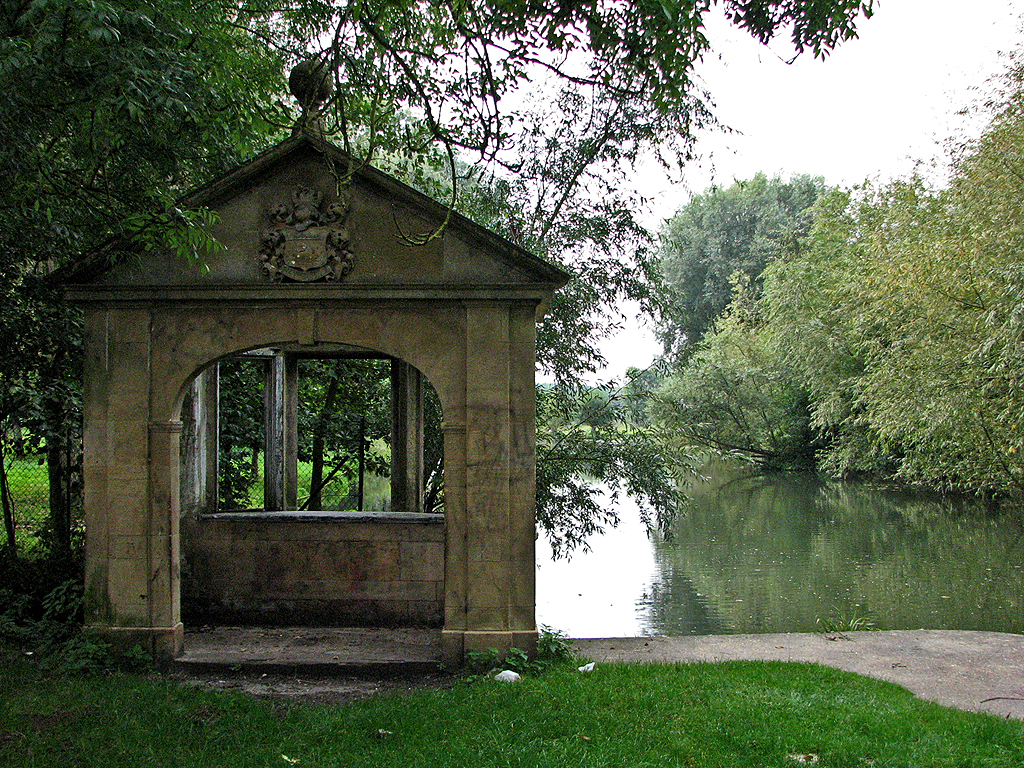Folly

|
| Hodson’s Folly was built in 1887 by John Hodson so that he could keep a watchful eye on his daughters bathing in the river while overseeing his nearby fish hatchery. The land used was common land which Hodson, who was at one point a butler’s assistant at Pembroke College, had annexed without permission. As a speculative builder, Hodson excelled: his building sports a coat of arms, showing a swan in a rain storm, and the summer house and its garden are in many ways a Cambridge college in miniature. (From the University of Cambridge website.) |
In architecture, a folly is typically a costly building that has been constructed for no specific purpose, or for which the original purpose has become obsolete or obscured over time. Its primary function is decorative, although it is sometimes also meant to demonstrate wealth or symbolise virtues.
In some instances, the construction of follies served as a method of employment for those who sought work. They also created projects for artisans who may have been struggling during difficult times.
Follies were often whimsical or eccentric structures that were made to project a false sense of age. For instance, they were made to look like ancient ruins (or sham ruins) despite being relatively modern constructions.
They were frequently constructed as towers, and like eyecatchers, they serve to create a focal point in a landscape, often on the grounds of a stately home. This attracts visual attention or otherwise punctuates the vista with a sense of drama.
Authentic ruins found on estates served as the original model for follies, which were first introduced in the 17th century. They became increasingly popular through the 18th and 19th centuries, adopting more exotic locations and depicting more fanciful eras.
[edit] Related articles on Designing Buildings
Featured articles and news
Government consultations for the summer of 2025
A year of Labour, past and present consultations on the environment, the built environment, training and tax.
CMA competitiveness probe of major housing developers
100 million affordable housing contributions committed with further consultation published.
Homes England supports Greencore Homes
42 new build affordable sustainable homes in Oxfordshire.
Zero carbon social housing: unlocking brownfield potential
Seven ZEDpod strategies for brownfield housing success.
CIOB report; a blueprint for SDGs and the built environment
Pairing the Sustainable Development Goals with projects.
Types, tests, standards and fires relating to external cladding
Brief descriptions with an extensive list of fires for review.
Latest Build UK Building Safety Regime explainer published
Key elements in one short, now updated document.
UKGBC launch the UK Climate Resilience Roadmap
First guidance of its kind on direct climate impacts for the built environment and how it can adapt.
CLC Health, Safety and Wellbeing Strategy 2025
Launched by the Minister for Industry to look at fatalities on site, improving mental health and other issues.
One of the most impressive Victorian architects. Book review.
Common Assessment Standard now with building safety
New CAS update now includes mandatory building safety questions.
RTPI leader to become new CIOB Chief Executive Officer
Dr Victoria Hills MRTPI, FICE to take over after Caroline Gumble’s departure.
Social and affordable housing, a long term plan for delivery
The “Delivering a Decade of Renewal for Social and Affordable Housing” strategy sets out future path.
A change to adoptive architecture
Effects of global weather warming on architectural detailing, material choice and human interaction.
The proposed publicly owned and backed subsidiary of Homes England, to facilitate new homes.
How big is the problem and what can we do to mitigate the effects?
Overheating guidance and tools for building designers
A number of cool guides to help with the heat.
The UK's Modern Industrial Strategy: A 10 year plan
Previous consultation criticism, current key elements and general support with some persisting reservations.
Building Safety Regulator reforms
New roles, new staff and a new fast track service pave the way for a single construction regulator.
























